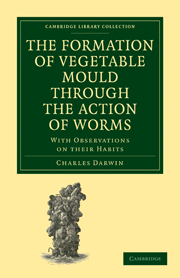Book contents
- Frontmatter
- Contents
- INTRODUCTION
- CHAPTER I HABITS OF WORMS
- CHAPTER II HABITS OF WORMS—continued
- CHAPTER III THE AMOUNT OF FINE EARTH BROUGHT UP BY WORMS TO THE SURFACE
- CHAPTER IV THE PART WHICH WORMS HAVE PLAYED IN THE BURIAL OF ANCIENT BUILDINGS
- CHAPTER V THE ACTION OF WORMS IN THE DENUDATION OF THE LAND
- CHAPTER VI THE DENUDATION OF THE LAND—continued
- CHAPTER VII CONCLUSION
- INDEX
CHAPTER III - THE AMOUNT OF FINE EARTH BROUGHT UP BY WORMS TO THE SURFACE
Published online by Cambridge University Press: 29 August 2010
- Frontmatter
- Contents
- INTRODUCTION
- CHAPTER I HABITS OF WORMS
- CHAPTER II HABITS OF WORMS—continued
- CHAPTER III THE AMOUNT OF FINE EARTH BROUGHT UP BY WORMS TO THE SURFACE
- CHAPTER IV THE PART WHICH WORMS HAVE PLAYED IN THE BURIAL OF ANCIENT BUILDINGS
- CHAPTER V THE ACTION OF WORMS IN THE DENUDATION OF THE LAND
- CHAPTER VI THE DENUDATION OF THE LAND—continued
- CHAPTER VII CONCLUSION
- INDEX
Summary
We now come to the more immediate subject of this volume, namely the amount of earth which is brought up by worms from beneath the surface, and is afterwards spread out more or less completely by the rain and wind. The amount can be judged of by two methods, —by the rate at which objects left on the surface are buried, and more accurately by weighing the quantity brought up within a given time. We will begin with the first method, as it was first followed.
Near Maer Hall in Staffordshire, quick-lime had been spread about the year 1827 thickly over a field of good pasture-land, which had not since been ploughed. Some square holes were dug in this field in the beginning of October 1837; and the sections showed a layer of turf, formed by the matted roots of the grasses, ½ inch in thickness, beneath which, at a depth of 2½ inches (or 3 inches from the surface), a layer of the lime in powder or in small lumps could be distinctly seen running all round the vertical sides of the holes. The soil beneath the layer of lime was either gravelly or of a coarse sandy nature, and differed considerably in appearance from the overlying dark-coloured fine mould. Coal-cinders had been spread over a part of this same field either in the year 1833 or 1834; and when the above holes were dug, that is after an interval of 3 or 4 years, the cinders formed a line of black spots round the holes, at a depth of 1 inch beneath the surface, parallel to and above the white layer of lime.
- Type
- Chapter
- Information
- The Formation of Vegetable Mould through the Action of WormsWith Observations on their Habits, pp. 129 - 175Publisher: Cambridge University PressPrint publication year: 2009First published in: 1881



